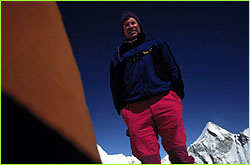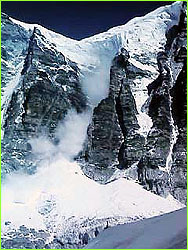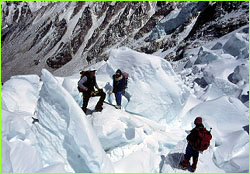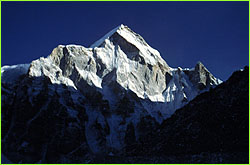 |
 |
 |
 Going Higher: Up to Camp II
Going Higher: Up to Camp IIPage 3 | Back to Page 2 "My O2 sat is 83 and my pulse is 105. Pete's O2 saturation is 70 and his pulse is 110. Jangbu's O2 saturation is 73 and his pulse is 103." A small pulse oximeter takes the readings from the tip of a finger by shining red and infrared light through the finger tissue. It detects arterial blood pulsations and measures hemoglobin oxygen saturation. At Base Camp, the climbers' pulse rates were between 60 and 80 and the percentage of oxygen saturation of the blood (or "O2 sat") was in the 80s. At sea level a person would normally have an oxygen saturation level of close to 100%. Peter Hackett, a high altitude physiology specialist, comments on the importance of our oxygen saturation readings: "It is perhaps the arterial oxygen saturation of the blood that is the most important variable in terms of oxygen transport to tissues, including the brain. The neuropsych tests and MRI scans [that we have conducted on the climbers] will be "correlated" with O2 sat values for each climber. It is important to point out that although the climbers will be at the same altitude, they may well have quite different O2  sat values because of their differences in HVR and ventilation, especially
during exercise and sleep. The brain cares about the O2 sat, not the altitude
per se."
sat values because of their differences in HVR and ventilation, especially
during exercise and sleep. The brain cares about the O2 sat, not the altitude
per se."9:00 am—A huge avalanche comes crashing down from Pumori, a high peak that looms above Base Camp. 10:00 am—If it's sunny out and warm (20 degrees F), it's time to wash hair, bathe, and wash any dirty clothes. Ask Chyangba for "tato pani" (hot water), and an aluminum bowl-full of steaming water appears in minutes. Shampoo and conditioner bottles (which are frozen) must be put into the warm water to melt. Within 30 seconds of beginning the shampooing process, hair and shampoo are a frozen mass of soapy white ice. Washing clothes can be equally novel. "Whites" are so dirty they turn the washing water black, and clothes on the line freeze instantly. After 20 minutes your T-shirt can be lifted off the line by the sleeve and the whole thing will come off stiff and intact, like a piece of cardboard-made clothing for a cut-out-and-paste-me-up doll. 10:30 am—Our climbing Sherpas return from carrying loads up to Camp II. They head into the kitchen tent and Lhakba Gyelze, the assistant head cook, boils up  some potatoes and rara (ramen) soup for them. After the meal they fall into
their tents and we don't see them again until before dinner.
some potatoes and rara (ramen) soup for them. After the meal they fall into
their tents and we don't see them again until before dinner.All day long, small black figures move slowly up through the blue and white glacial ice of the Khumbu Icefall. With binoculars you can spot individual climbers making their way around the myriad ice boulders. Avalanches break free from hanging glaciers on the Lho La and the west shoulder of Everest all day long, and we learn to step out of our tents to watch only the ones that roar the loudest. 12:00—Pete Athans radios us and says they've made it to Camp II and are having lunch. We then administer psychometric tests on all five climbers (David, Pete, Jangbu, Ed, and Carter) and find that they don't seem to be greatly affected by the altitude; their reaction times to the tests are slowing somewhat, but they still perform the majority of the tests perfectly. Mostly, they are fatigued from the physical efforts of the day. Ed and Carter have been up to Camp III and have returned to sleep at Camp II, also known as Advance Base Camp, where kitchens are set up to cook for the sojourning climbers. 1:30 pm—Lhakba Gyelze appears in the dining tent with lunch for those of us remaining at Base Camp. Today, it's soup and chapatis with cheese, tomatoes, and onions. By the afternoon, clouds inevitably roll in, the temperature drops, and layers of clothing are put on again. 4:00 pm—Snow usually starts to fall by 4:00 and we begin to gather in the kitchen tent, where the activity of cooking becomes the evening's entertainment  for the next three hours. I linger in the dining tent, typing responses to
e-mails or writing on the laptop even as my fingers begin to feel large and
uncoordinated. The light falls as the climbers call in for the last time of
the day to say goodnight. When you're on the mountain, you crawl into your
tent and sleeping bag as soon as the light fades to preserve what warmth you
have left for the night.
for the next three hours. I linger in the dining tent, typing responses to
e-mails or writing on the laptop even as my fingers begin to feel large and
uncoordinated. The light falls as the climbers call in for the last time of
the day to say goodnight. When you're on the mountain, you crawl into your
tent and sleeping bag as soon as the light fades to preserve what warmth you
have left for the night.Lhakba fills our water bottles with boiling water and we don headlamps to light the way to our tents. Toothpaste is frozen solid, but somehow a smudge of it appears on my toothbrush. Standing atop a slab of ice, brushing my teeth in the frozen air as a light snow falls, I look up the Icefall toward where the climbers are camped. They must be asleep by now, snuggled tightly in their sleeping bags, breathing at a rate higher than normal in the thin air at Camp III. Follow the climbers from Camp II to Camp III, or log on to our newsflashes for more regular updates from the field. Photos: (1, 2, 4, 8, 10) Liesl Clark; (3, 5-7, 9) David Breashears. Lost on Everest | High Exposure | Climb | History & Culture | Earth, Wind, & Ice E-mail | Previous Expeditions | Resources | Site Map | Everest Home Editor's Picks | Previous Sites | Join Us/E-mail | TV/Web Schedule About NOVA | Teachers | Site Map | Shop | Jobs | Search | To print PBS Online | NOVA Online | WGBH © | Updated November 2000 |